IN REVIEW: KCB dancers, plus others, create New Moves
The Kansas City Ballet’s New Moves is gradually coming into its own. The project that Artistic Director Devon Carney launched shortly after arriving in 2013 (an outgrowth of a previous series consisting chiefly of works by Company members) mixes works by aspiring KCB choreographers with dances by prominent visiting artists whose professionalism has at times made for awkward juxtapositions.
The program on February 15th in the Todd Bolender Center’s intensely intimate Studio One was one of the more engaging blends of styles I’ve seen in this context, and it made me entertain the idea that young choreographers perhaps welcome the chance to appear together with more experienced dance-makers: Rather than intimidate, it may indeed foster a youngster’s growth to work in a relatively high-profile setting. The stated goal of New Moves is to provide a “cross-section of choreographic perspectives” as Devon writes—and to draw from a broad artistic and geographic spread toward representing “emerging voices from the national dance scene and from within our own ballet company.” Each piece on this program, he wrote, “was created and painstakingly rehearsed under this roof,” which indeed lent a nice sort of authenticity to the undertaking.
 The program included works by three current Company dancers, beginning with Emily Mistretta’s Beyond Blood, a trio for one woman (Elysa Hotchkiss) and two men (Humberto Rivera Blanco and Cameron Thomas) danced to a melancholy blues-pop song by Shakey Graves. The choreographer writes in the program about conveying the sense of “traveling through time and space with the people you came into this world with.” The dance seemed to suggest a sort of sharp-edged rivalry of the two men for the affections of the woman, though the description may allude to squabbling siblings. The tension was underscored by lighting designs (by Amy Taylor, here as throughout the evening) that included a strong diagonal swath of light and an unexpected shift to cool colors. The song ends with a sound track of a woman discussing an uncertain future. (“What do you look for in a boy?” … “What are your plans for the future?” “I don’t have any.”)
The program included works by three current Company dancers, beginning with Emily Mistretta’s Beyond Blood, a trio for one woman (Elysa Hotchkiss) and two men (Humberto Rivera Blanco and Cameron Thomas) danced to a melancholy blues-pop song by Shakey Graves. The choreographer writes in the program about conveying the sense of “traveling through time and space with the people you came into this world with.” The dance seemed to suggest a sort of sharp-edged rivalry of the two men for the affections of the woman, though the description may allude to squabbling siblings. The tension was underscored by lighting designs (by Amy Taylor, here as throughout the evening) that included a strong diagonal swath of light and an unexpected shift to cool colors. The song ends with a sound track of a woman discussing an uncertain future. (“What do you look for in a boy?” … “What are your plans for the future?” “I don’t have any.”)
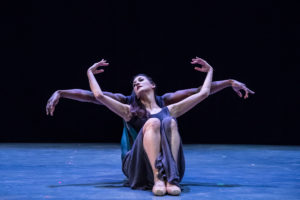 The fluidity of Christopher Constantini’s Evanesco stood in strong (and somewhat refreshing) contrast to Emily’s modernist angularity. Set to the opening movement of Mendelssohn’s Violin Concerto, it featured two dancers (Emily Mistretta and Joshua Bodden) in a beautifully polished pas de deux, all rounded edges and balletic playfulness. There was an almost comic undercurrent in the way the two “backed into each other” at times, seeming unaware of each other’s presence, only to circle back and rediscover the sheer fun of traditional pairing.
The fluidity of Christopher Constantini’s Evanesco stood in strong (and somewhat refreshing) contrast to Emily’s modernist angularity. Set to the opening movement of Mendelssohn’s Violin Concerto, it featured two dancers (Emily Mistretta and Joshua Bodden) in a beautifully polished pas de deux, all rounded edges and balletic playfulness. There was an almost comic undercurrent in the way the two “backed into each other” at times, seeming unaware of each other’s presence, only to circle back and rediscover the sheer fun of traditional pairing.
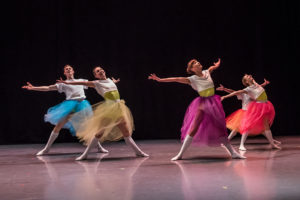 The final Company choreographer was Michael Davis, whose You Do You! featured dance that was every bit as lackadaisical as the folk-rock party-music by Edward Sharpe and the Magnetic Zeros to which it was set. When creating pairings for odd numbers of dancers (five in this case: Danielle Bausinger, Angelina Sansone, Sarah Joan Smith, Charles Martin and James Kirby Rogers) you’re bound to leave someone out. The Whitener-esque effect was one of a playground or beach campfire, with youthful dancers looking fearfully for ways to “conform.” Angelina danced a loopy, headstrong solo, initially uncertain about her boldly frilly skirt: At the end she was proven to have been the trend-setter, though, as everyone dons a similar skirt.
The final Company choreographer was Michael Davis, whose You Do You! featured dance that was every bit as lackadaisical as the folk-rock party-music by Edward Sharpe and the Magnetic Zeros to which it was set. When creating pairings for odd numbers of dancers (five in this case: Danielle Bausinger, Angelina Sansone, Sarah Joan Smith, Charles Martin and James Kirby Rogers) you’re bound to leave someone out. The Whitener-esque effect was one of a playground or beach campfire, with youthful dancers looking fearfully for ways to “conform.” Angelina danced a loopy, headstrong solo, initially uncertain about her boldly frilly skirt: At the end she was proven to have been the trend-setter, though, as everyone dons a similar skirt.
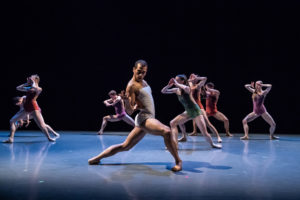 Visiting choreographers included Abdur-Rahim Jackson, whose aBnOrMaL Normal for eight dancers began in silence and unfolded into a series of light-hearted poses and twitches: passages in which dancers facing upstage jolted and jerked shoulders only. Again there was often an “odd man out” sensibility built into the group dances, and the comedic potential—of self-slaps and hand-swirls, pushes and arms-around-head moves—felt diminished by the newly created, vaguely hypnotic music, which lent little structure and no forward-motion to the dance.
Visiting choreographers included Abdur-Rahim Jackson, whose aBnOrMaL Normal for eight dancers began in silence and unfolded into a series of light-hearted poses and twitches: passages in which dancers facing upstage jolted and jerked shoulders only. Again there was often an “odd man out” sensibility built into the group dances, and the comedic potential—of self-slaps and hand-swirls, pushes and arms-around-head moves—felt diminished by the newly created, vaguely hypnotic music, which lent little structure and no forward-motion to the dance.
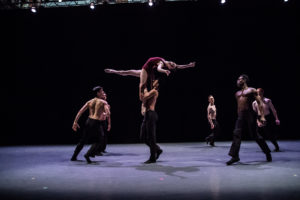 Mariana Oliviera’s Beauty in Chaos was a sophisticated ballet set to the Bachiana Brasileira No. 8 of Villa-Lobos, in which a single woman (Amanda DeVenuta) and six shirtless men etch what seems to be a narrative of a couple trying to pair up as their social circles attempt to keep them apart—with nods to Taylor and Robbins, perhaps, not to mention a commitment to fluid sexual pairings. Mariana writes in her program note of a desert flower blossoming in a precarious environment. These two narratives are perhaps compatible, with the woman symbolizing the flower: At the end she is held high by two men, as three others hold one male dancer apart from her, as if to protect the tender flower from overbearing heat.
Mariana Oliviera’s Beauty in Chaos was a sophisticated ballet set to the Bachiana Brasileira No. 8 of Villa-Lobos, in which a single woman (Amanda DeVenuta) and six shirtless men etch what seems to be a narrative of a couple trying to pair up as their social circles attempt to keep them apart—with nods to Taylor and Robbins, perhaps, not to mention a commitment to fluid sexual pairings. Mariana writes in her program note of a desert flower blossoming in a precarious environment. These two narratives are perhaps compatible, with the woman symbolizing the flower: At the end she is held high by two men, as three others hold one male dancer apart from her, as if to protect the tender flower from overbearing heat.
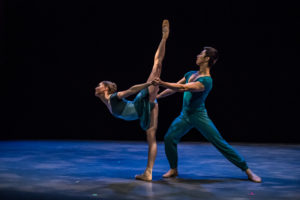 Monique Meunier’s Quatre Pièces de Clavecin featured live music performed by Ballet Music Director Ramona Pansegrau (playing Rameau on piano, stage right, unseen yet amplified throughout the space). Five women en pointe almost appeared to be in a dance-class setting, as they patiently awaited the preening Liang Fu, who was practicing pirouettes. Lamin Pereira dos Santos extended the dance, while Fu and the others joined in pairs and trios; Tempe Ostergren’s final solo was both Baroque and Firebird—a stately, fine-tuned, modern-edged echo of courtly dance.
Monique Meunier’s Quatre Pièces de Clavecin featured live music performed by Ballet Music Director Ramona Pansegrau (playing Rameau on piano, stage right, unseen yet amplified throughout the space). Five women en pointe almost appeared to be in a dance-class setting, as they patiently awaited the preening Liang Fu, who was practicing pirouettes. Lamin Pereira dos Santos extended the dance, while Fu and the others joined in pairs and trios; Tempe Ostergren’s final solo was both Baroque and Firebird—a stately, fine-tuned, modern-edged echo of courtly dance.
It was perhaps a bold move to open the evening with the most accomplished work on the program, Fractals by Parrish Maynard, who in addition to being a KCB Ballet Master is also a choreographer of considerable renown.
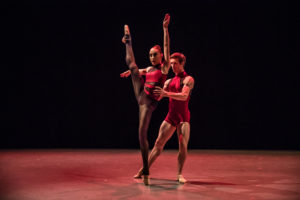 Set to a repetitive score of non-descript thumping, the fantastically intricate dances were first placed in three rectangles of intense overhead light, each a sort of “stage” unto itself into which men and women appeared and disappeared. (There were 14 dancers in this version, which was recreated specifically for the members of KCB II and the Company’s Trainee program.) In rapid succession we observed tight classical turns followed by modern-funk swoops, nods to story-ballet aesthetic followed by doses of Forsythian attempts to break the body into individual “moving parts.” “Hard and edgy,” in the choreographer’s words, the piece was so visually dazzling as to make one almost forget that the music was adding little if anything to the whole.
Set to a repetitive score of non-descript thumping, the fantastically intricate dances were first placed in three rectangles of intense overhead light, each a sort of “stage” unto itself into which men and women appeared and disappeared. (There were 14 dancers in this version, which was recreated specifically for the members of KCB II and the Company’s Trainee program.) In rapid succession we observed tight classical turns followed by modern-funk swoops, nods to story-ballet aesthetic followed by doses of Forsythian attempts to break the body into individual “moving parts.” “Hard and edgy,” in the choreographer’s words, the piece was so visually dazzling as to make one almost forget that the music was adding little if anything to the whole.
—By Paul Horsley
All photos by Brett Pruitt and East Market Studios.
For tickets to upcoming KC Ballet events call 816-931-8993 or go to kcballet.org.
To reach Paul Horsley, performing arts editor, send email to paul@kcindependent.com or find him on Facebook (paul.horsley.501) or Twitter (@phorsleycritic).
Features

Tyrone Aiken danced prodigiously as a youth, trained at The Ailey School as a young adult, worked as a professional dancer at the height of the New York dance ferment,…
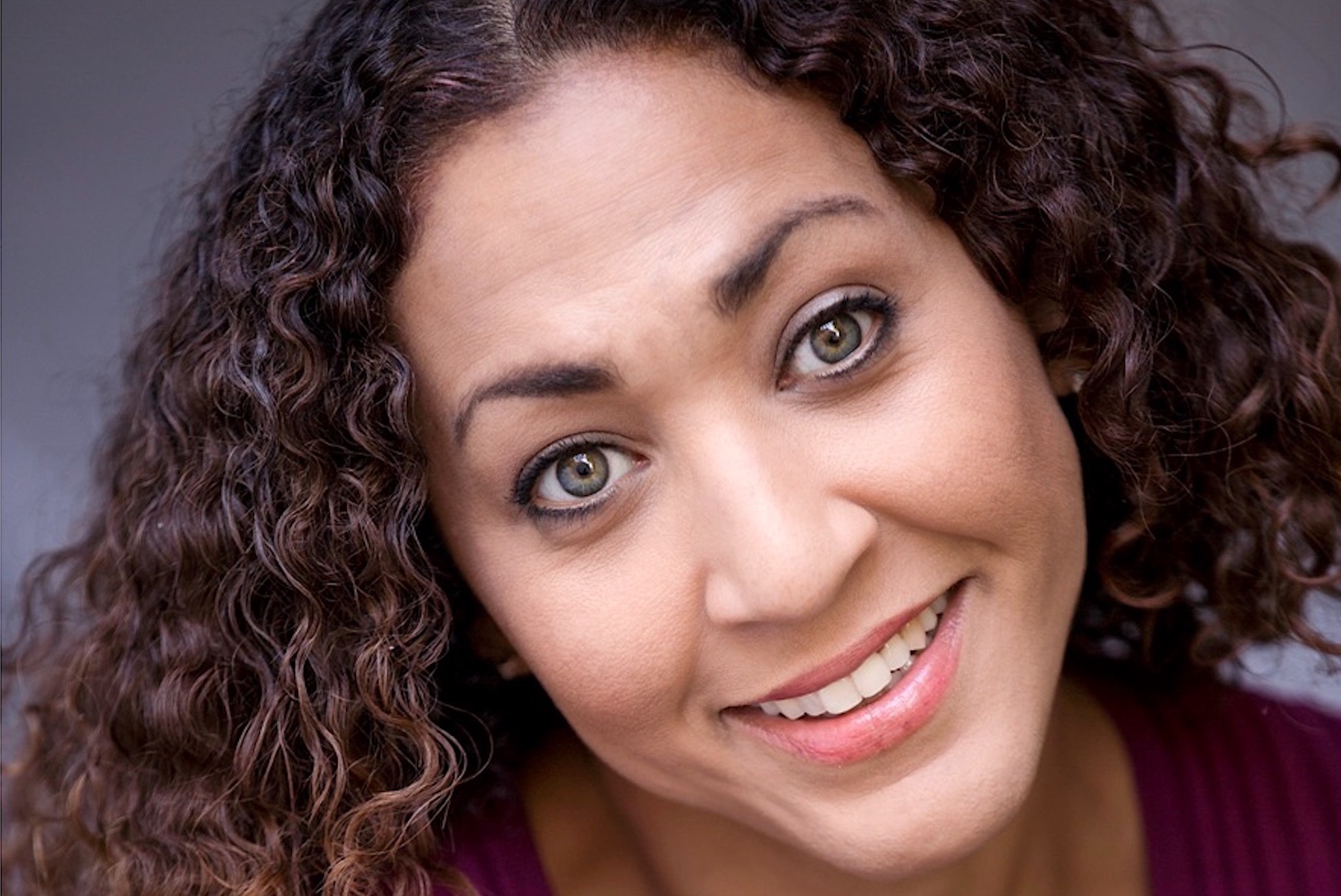
CAROLINE DAHM Dancer, choreographer, producer, master teacher, adjunct dance professor at The UMKC Conservatory, assistant director at Wylliams/Henry Contemporary Dance Company What I love about the Kansas City performing-arts scene: Kansas…
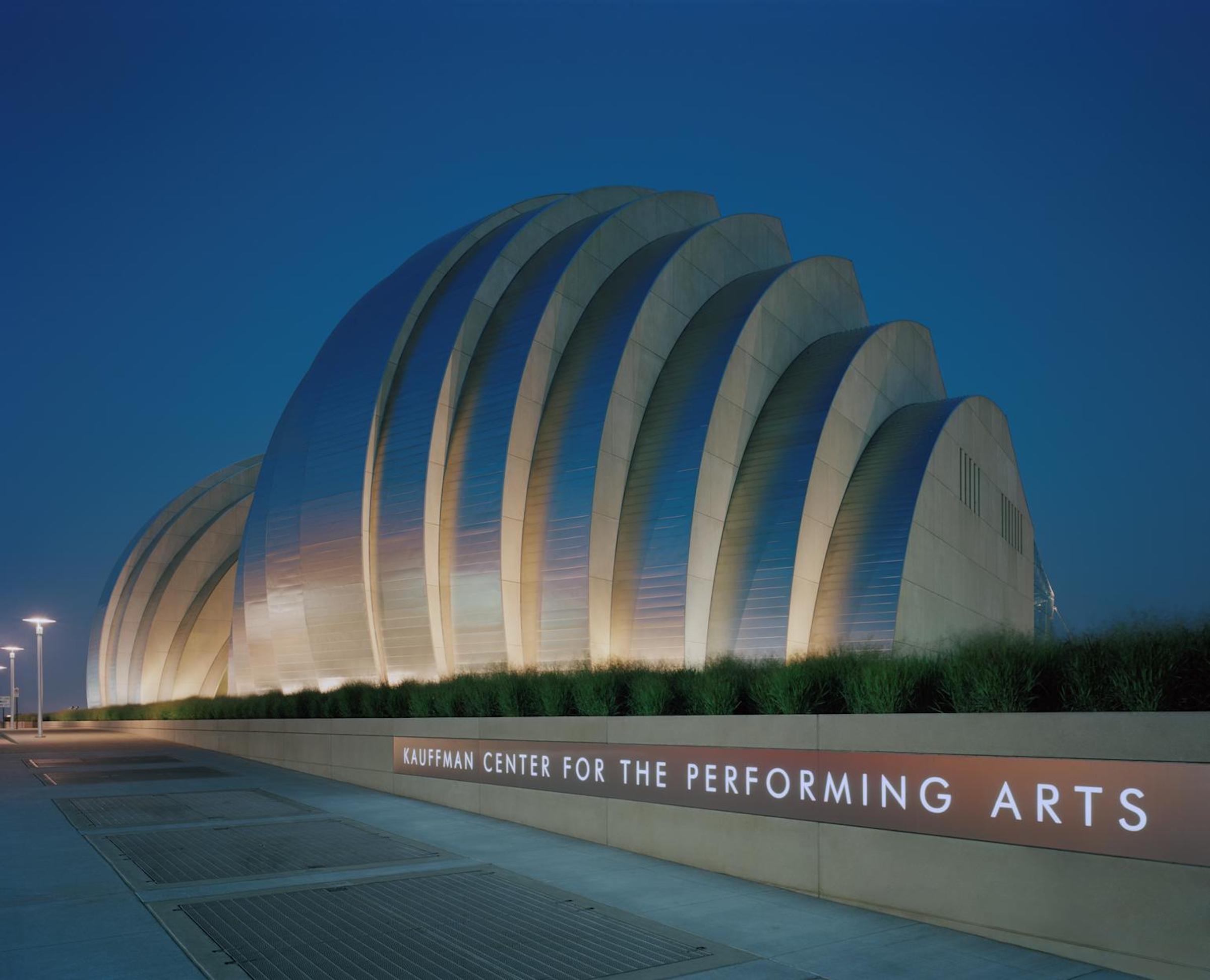
It’s difficult to remember what the Kansas City skyline looked like 20 years ago, before the Kauffman Center for the Performing Arts began to take shape at 16th and Broadway.…






